Efficient Evaluation of Multiple-Output Boolean Functions in Embedded Software or Firmware
选择题英语作文
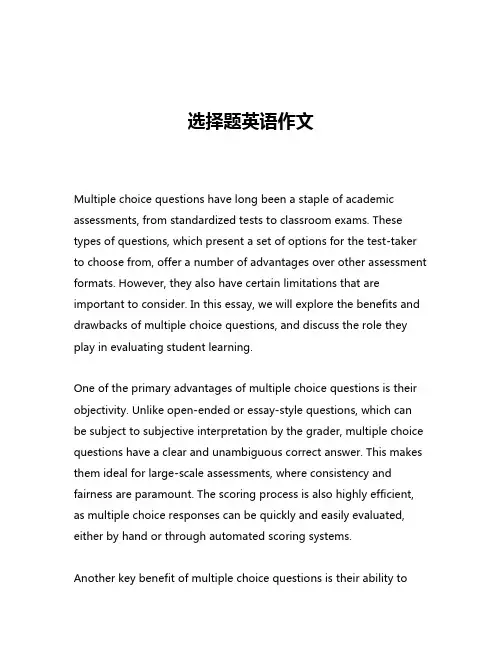
选择题英语作文Multiple choice questions have long been a staple of academic assessments, from standardized tests to classroom exams. These types of questions, which present a set of options for the test-taker to choose from, offer a number of advantages over other assessment formats. However, they also have certain limitations that are important to consider. In this essay, we will explore the benefits and drawbacks of multiple choice questions, and discuss the role they play in evaluating student learning.One of the primary advantages of multiple choice questions is their objectivity. Unlike open-ended or essay-style questions, which can be subject to subjective interpretation by the grader, multiple choice questions have a clear and unambiguous correct answer. This makes them ideal for large-scale assessments, where consistency and fairness are paramount. The scoring process is also highly efficient, as multiple choice responses can be quickly and easily evaluated, either by hand or through automated scoring systems.Another key benefit of multiple choice questions is their ability tocover a broad range of content in a relatively concise format. By presenting a set of options, these questions can assess a student's knowledge of a wide variety of topics or concepts, without requiring lengthy written responses. This makes them well-suited for exams that need to cover a significant amount of material in a limited amount of time, such as standardized tests or final exams.Furthermore, multiple choice questions can be designed to test a variety of cognitive skills, from simple recall of factual information to more complex problem-solving and critical thinking abilities. By carefully crafting the question stem and the response options, instructors can create multiple choice items that assess a range of learning objectives, from basic comprehension to higher-order thinking.However, multiple choice questions also have some limitations that are important to consider. One of the primary criticisms is that they can encourage a "guessing" mentality, where students attempt to identify the correct answer through process of elimination, rather than demonstrating a deep understanding of the material. This can be particularly problematic in situations where the stakes are high, such as high-stakes standardized tests, as it can lead to inflated scores that do not accurately reflect a student's true knowledge and abilities.Another potential drawback of multiple choice questions is their inability to assess certain types of skills, such as written communication, problem-solving, or creative thinking. These skills are often better evaluated through open-ended or performance-based assessments, where students have the opportunity to demonstrate their abilities in a more authentic and comprehensive manner.Additionally, the construction of effective multiple choice questions can be challenging, requiring careful attention to the wording of the question stem and the response options. Poorly designed multiple choice items can be confusing or ambiguous, leading to inaccurate assessments of student learning.Despite these limitations, multiple choice questions continue to play a significant role in academic assessment, and they are likely to remain a prominent feature of many educational contexts. However, it is important for instructors and test developers to use these types of questions judiciously and in conjunction with other assessment methods, in order to provide a comprehensive and accurate evaluation of student learning.In conclusion, multiple choice questions offer a number of advantages, including objectivity, efficiency, and the ability to assess a broad range of content and cognitive skills. However, they alsohave certain limitations, such as the potential for guessing, the inability to assess certain types of skills, and the challenge of creating effective question items. By understanding both the benefits and drawbacks of multiple choice questions, educators can make informed decisions about how to best utilize them as part of a comprehensive assessment strategy.。
人工智能英语作文批改
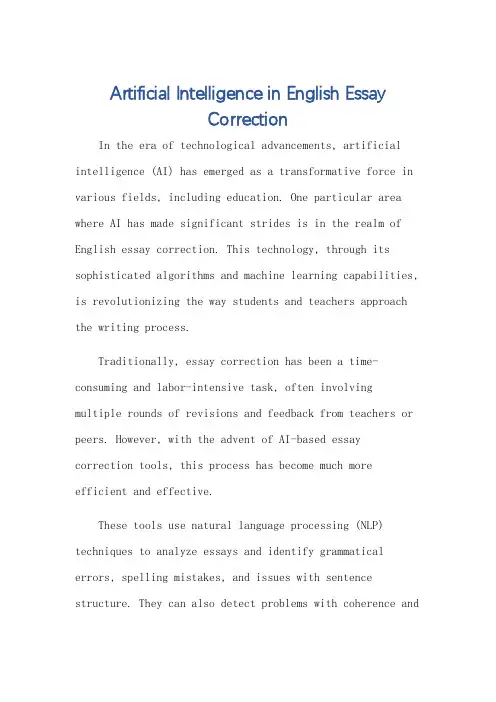
Artificial Intelligence in English EssayCorrectionIn the era of technological advancements, artificial intelligence (AI) has emerged as a transformative force in various fields, including education. One particular area where AI has made significant strides is in the realm of English essay correction. This technology, through its sophisticated algorithms and machine learning capabilities, is revolutionizing the way students and teachers approach the writing process.Traditionally, essay correction has been a time-consuming and labor-intensive task, often involvingmultiple rounds of revisions and feedback from teachers or peers. However, with the advent of AI-based essaycorrection tools, this process has become much moreefficient and effective.These tools use natural language processing (NLP) techniques to analyze essays and identify grammatical errors, spelling mistakes, and issues with sentence structure. They can also detect problems with coherence andlogical flow, providing valuable insights into how theessay can be improved.One of the key advantages of AI-based essay correctionis its ability to provide instant feedback. Unlike human graders or teachers, who may take days or even weeks to return corrected essays, AI tools can provide real-time feedback as students are writing. This immediate feedback loop allows students to quickly identify and correct errors, leading to improved writing skills over time.Moreover, AI essay correction tools are not limited by human biases or subjectivity. They analyze essays based on objective criteria and predefined rules, ensuringconsistent and unbiased evaluation. This is particularly beneficial for students who may feel anxious or intimidated by the prospect of receiving subjective feedback from teachers or peers.Despite these advantages, it is important to note that AI-based essay correction tools are not a replacement for human teachers or graders. While they can identify and correct many types of errors, they may not always capture the nuances of language or the subtleties of argumentation.Therefore, it is essential for students to use these tools as a supplement to, rather than a substitute for,traditional writing instruction and feedback.In conclusion, artificial intelligence hasrevolutionized the field of English essay correction, making the process more efficient, effective, and objective. By leveraging AI-based tools, students can receive instant feedback, identify and correct errors quickly, andultimately improve their writing skills. While these tools are not a complete replacement for human teachers or graders, they can serve as a valuable resource in enhancing the writing process.**人工智能在英语作文批改中的应用**在科技飞速发展的时代,人工智能(AI)已经成为各个领域变革的推动力量,教育领域也不例外。
performance evaluation理工英语4
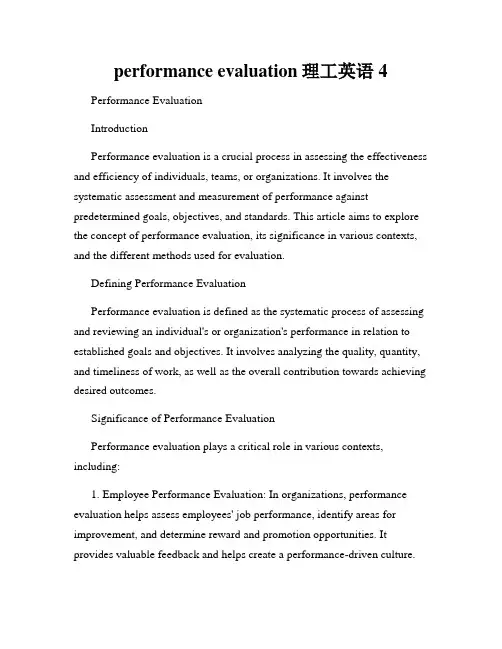
performance evaluation理工英语4 Performance EvaluationIntroductionPerformance evaluation is a crucial process in assessing the effectiveness and efficiency of individuals, teams, or organizations. It involves the systematic assessment and measurement of performance against predetermined goals, objectives, and standards. This article aims to explore the concept of performance evaluation, its significance in various contexts, and the different methods used for evaluation.Defining Performance EvaluationPerformance evaluation is defined as the systematic process of assessing and reviewing an individual's or organization's performance in relation to established goals and objectives. It involves analyzing the quality, quantity, and timeliness of work, as well as the overall contribution towards achieving desired outcomes.Significance of Performance EvaluationPerformance evaluation plays a critical role in various contexts, including:1. Employee Performance Evaluation: In organizations, performance evaluation helps assess employees' job performance, identify areas for improvement, and determine reward and promotion opportunities. It provides valuable feedback and helps create a performance-driven culture.2. Team Performance Evaluation: Evaluating team performance is essential for identifying strengths and weaknesses, enhancing collaboration, and optimizing resources. It enables organizations to allocate tasks effectively, promote teamwork, and achieve collective goals.3. Organizational Performance Evaluation: Assessing the overall performance of an organization is essential for strategic planning, decision-making, and performance improvement. It helps identify areas requiring attention and enables organizations to align their objectives with key performance indicators (KPIs).Methods of Performance EvaluationThere are several methods used for performance evaluation, depending on the nature and context of evaluation:1. Rating Scales: This method involves using predefined scales to rate employees' performance against specific criteria. It provides a structured approach and simplifies the evaluation process. However, it can be subjective and may not capture the full extent of performance.2. 360-Degree Feedback: This method involves obtaining feedback from multiple sources, including supervisors, subordinates, peers, and customers. It provides a holistic view of an individual's performance and promotes a comprehensive understanding of strengths and areas for improvement.3. Objective Measurements: Objective measurements involve quantifying performance based on quantifiable data, such as sales figures, production output, or customer satisfaction ratings. This method provides a precise assessment of performance but may not capture qualitative aspects.4. Self-Assessment: Self-assessment encourages individuals to reflect on their performance and identify areas for improvement. It promotes self-awareness, accountability, and personal development. However, it may be biased and influenced by individuals' perceptions.5. Behavioral Observation: This method involves directly observing individuals' behavior in specific work-related situations. It provides valuable insights into work habits, interpersonal skills, and adherence to organizational values. However, it can be time-consuming and may not capture performance in all areas.ConclusionPerformance evaluation is a vital process for assessing and improving individual, team, and organizational performance. It helps organizations align their objectives, motivate employees, and ensure efficient resource allocation. By using appropriate evaluation methods, organizations can drive continuous improvement and achieve long-term success. It is essential for organizations to establish clear evaluation criteria, provide constructive feedback, and support employee development to maximize the benefits of performance evaluation.。
信息类专业英语翻译

Dynamic topology:As the channel of communicationchanges, some of the neighbors who were reachable on theprevious channel might not be reachable on the currentchannel and vice versa. As a result the topology of the network changes with the change in frequency of operation resulting in route failures and packet loss.Heterogeneity:Different channels may support differenttransmission ranges, data rates and delay characteristics.Spectrum-Handoff delay:For each transition from onechannel to another channel due to the PU’s activity, thereis a delay involved in the transition called Spectrum- Handoff delay.All these factors decrease the predictability of the cause oftransit-delay and subsequent packet loss on the network. Thetime latency during channel hand-off in cognitive networksmight cause the TCP round trip timer to time out. TCP willwrongly recognize the delays and losses due to the abovefactors as network congestion and immediately take steps toreduce the congestion window size knowing not the cause ofpacket delay. This reduces the efficiency of the protocol insuch environments.动态技术:随着信道通信的变化,一些邻进信道的用户在原信道没有发生变化而在新信道发生变化,或者相反。
多智能体强化学习的几种BestPractice
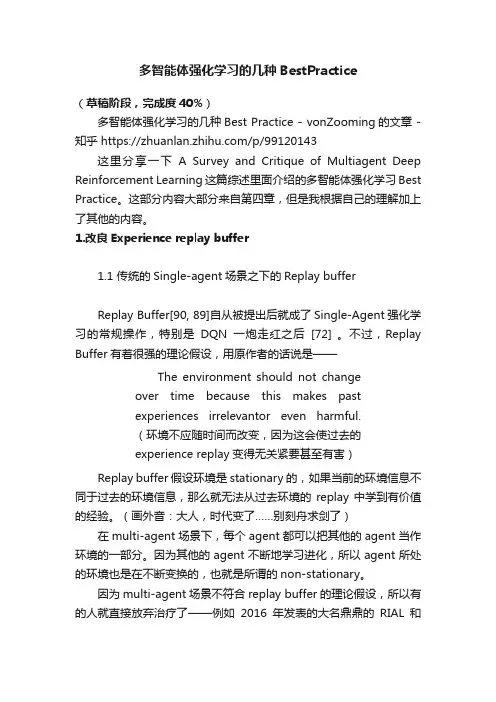
多智能体强化学习的几种BestPractice(草稿阶段,完成度40%)多智能体强化学习的几种Best Practice - vonZooming的文章 - 知乎 https:///p/99120143这里分享一下A Survey and Critique of Multiagent Deep Reinforcement Learning这篇综述里面介绍的多智能体强化学习Best Practice。
这部分内容大部分来自第四章,但是我根据自己的理解加上了其他的内容。
1.改良Experience replay buffer1.1 传统的Single-agent场景之下的Replay bufferReplay Buffer[90, 89]自从被提出后就成了Single-Agent强化学习的常规操作,特别是DQN一炮走红之后[72] 。
不过,Replay Buffer有着很强的理论假设,用原作者的话说是——The environment should not changeover time because this makes pastexperiences irrelevantor even harmful.(环境不应随时间而改变,因为这会使过去的experience replay变得无关紧要甚至有害)Replay buffer假设环境是stationary的,如果当前的环境信息不同于过去的环境信息,那么就无法从过去环境的replay中学到有价值的经验。
(画外音:大人,时代变了……别刻舟求剑了)在multi-agent场景下,每个agent都可以把其他的agent当作环境的一部分。
因为其他的agent不断地学习进化,所以agent所处的环境也是在不断变换的,也就是所谓的non-stationary。
因为multi-agent场景不符合replay buffer的理论假设,所以有的人就直接放弃治疗了——例如2016年发表的大名鼎鼎的RIAL和DIAL中就没有使用replay buffer。
学术报告 英文
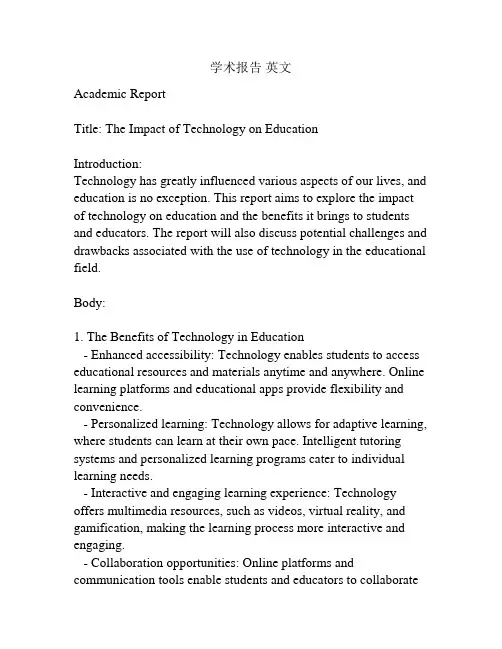
学术报告英文Academic ReportTitle: The Impact of Technology on EducationIntroduction:Technology has greatly influenced various aspects of our lives, and education is no exception. This report aims to explore the impact of technology on education and the benefits it brings to students and educators. The report will also discuss potential challenges and drawbacks associated with the use of technology in the educational field.Body:1. The Benefits of Technology in Education- Enhanced accessibility: Technology enables students to access educational resources and materials anytime and anywhere. Online learning platforms and educational apps provide flexibility and convenience.- Personalized learning: Technology allows for adaptive learning, where students can learn at their own pace. Intelligent tutoring systems and personalized learning programs cater to individual learning needs.- Interactive and engaging learning experience: Technology offers multimedia resources, such as videos, virtual reality, and gamification, making the learning process more interactive and engaging.- Collaboration opportunities: Online platforms and communication tools enable students and educators to collaborateand exchange ideas beyond the boundaries of the physical classroom.- Improved assessment methods: Technology provides various assessment tools, such as online quizzes and automated grading, which allow for immediate feedback and more efficient evaluation of student progress.2. Challenges and Drawbacks of Technology in Education- Unequal access: Not all students have equal access to technology and the internet, creating a digital divide and potentially exacerbating educational inequalities.- Distraction and reduced attention span: The use of technology in the classroom may lead to distractions and reduced attention span, hindering effective learning.- Reliability and technical difficulties: Technological issues and malfunctions may occur, disrupting the learning process and causing frustration for both students and educators.- Privacy and security concerns: The integration of technology in education raises concerns about the privacy and security of students' personal information and data.Conclusion:Technology has positively impacted education by enhancing accessibility, personalizing learning, creating interactive learning experiences, facilitating collaboration, and improving assessment methods. However, challenges such as unequal access, distractions, technical difficulties, and privacy concerns need to be considered and addressed. It is essential for educators and policymakers to strike a balance between utilizing technology effectively andensuring the appropriate use of technology in the educational setting.。
解决方案 英文
SolutionIntroductionIn today’s complex and evolving world, finding effective solutions to various challenges and problems has become essential. In this document, we will explore the concept of solution and present a comprehensive guide on how to develop and implement effective solutions. We will discuss the importance of understanding the problem, identifying stakeholders, conducting thorough research and analysis, exploring all possible options, and evaluating the outcomes. Our goal is to equip you with valuable insights and techniques to solve problems efficiently and effectively.Understanding the ProblemBefore jumping into developing a solution, it is crucial to have a deep understanding of the problem at hand. To do this, it is important to gather relevant information, identify the root causes, and analyze the potential impacts of the problem. This step forms the foundation for effective problem solving.Gathering InformationTo adequately understand a problem, it is crucial to gather relevant information from a variety of sources. This may include conducting interviews, researching existing studies, reviewing data and statistics, or observing the problem firsthand. By gathering diverse perspectives and data, a comprehensive understanding of the problem can be achieved.Identifying Root CausesTo solve a problem successfully, it is essential to identify the underlying root causes. By addressing these causes, it is possible to prevent the problem from recurring. Various tools and techniques, such as root cause analysis or fishbone diagrams, can be employed to identify these causes accurately.Analyzing Potential ImpactsUnderstanding the potential impacts of a problem is critical in prioritizing the development and implementation of a solution. By assessing the consequences of the problem, it is possible to determine its urgency and allocate resources accordingly.Identifying StakeholdersWhen developing a solution, it is crucial to identify and involve relevant stakeholders. Stakeholders are individuals or groups who are directly or indirectly affected by the problem and its potential solutions. Engaging stakeholders in theproblem-solving process can enhance collaboration, gather diverse viewpoints, and increase the chances of developing a successful solution.Stakeholder AnalysisStakeholder analysis involves identifying and evaluating the interests, needs, and potential influence of various stakeholders. This analysis helps prioritize stakeholders and determine the most effective approach to engage them in the problem-solving process.Collaborative Decision MakingInvolving stakeholders in decision-making processes ensures that all perspectives are considered, fostering buy-in and support for the proposed solution. Collaborative decision making can be achieved through workshops, focus groups, or online platforms, allowing stakeholders to contribute their insights, knowledge, and experience.Conducting Research and AnalysisComprehensive research and analysis are essential for developing effective solutions. This stage involves examining existing solutions, conducting feasibility studies, and exploring alternative options.Examining Existing SolutionsBefore reinventing the wheel, it is important to examine existing solutions that have been implemented in similar contexts. This research can provide valuable insights, best practices, and lessons learned, aiding in the development of a more efficient and effective solution.Feasibility StudiesAssessing the feasibility of potential solutions is critical in ensuring their practicality and viability. Feasibility studies include evaluating the technical, economic, legal, and organizational aspects of the proposed solution. This analysis helps identify potential constraints, risks, and opportunities associated with each solution.Exploring Alternative OptionsExploring various alternatives is essential to find the most suitable solution. This may involve brainstorming sessions, conducting pilot projects, or implementing small-scale tests. By exploring different options, it is possible to identify innovative approaches or refine existing solutions for better results.Evaluating OutcomesTo determine the success of a solution, it is critical to evaluate its outcomes and impacts. This evaluation helps identify areas of improvement, measure the effectiveness of the solution, and inform future problem-solving endeavors.Defining Evaluation CriteriaBefore implementing a solution, it is important to define evaluation criteria that will be used to measure its success. These criteria may include specific performance metrics, client satisfaction, cost-effectiveness, or social and environmental impacts.Monitoring and EvaluationThroughout the implementation of a solution, continuous monitoring and evaluation are essential. This enables real-time adjustments and ensures that the solution remains aligned with the desired outcomes. Monitoring and evaluation can involve data collection, surveys, interviews, or the use of monitoring tools.Learning from OutcomesLearning from the outcomes of a solution is crucial for ongoing improvement and growth. By critically assessing the results, analyzing the successes and failures, and collecting feedback from stakeholders, valuable insights can be gained for future problem-solving initiatives.ConclusionDeveloping effective solutions requires a systematic and comprehensive approach. By understanding the problem, identifying stakeholders, conducting research and analysis, and evaluating outcomes, it is possible to develop and implement solutions that address the root causes and have a positive impact. This document provides a comprehensive guide to help you enhance your problem-solving skills and achieve more successful outcomes. Actively applying these strategies and techniques will enable you to contribute to positive changes and progress in various domains.。
雷达图分析法在中职英语教学评价中的应用
雷达图分析法在中职英语教学评价中的应用Radar chart analysis method is a kind of systematic evaluation method. It is widely used in many fields such as management review and assessment. In recent years, it has also been widely used in the evaluation of vocational high school English teaching.仪表盘图分析法是一种系统的评价方法,它在许多领域被广泛应用,如管理审核和评估。
近年来,它也被广泛用于中职英语教学的评价。
Radar chart analysis is also called "Star Chart" in China. It uses closed curve and uniform interval scale to reflect the evaluation result of multiple evaluation indicators. The 5 basic parts of radar chart analysis are: evaluation items, uniform interval scale, evaluation results, closed curve and evaluation report.雷达图分析在中国也称为“星形图”,它利用闭合曲线和统一间隔标度来反映多个评价指标的评价结果。
雷达图分析的5个基本部分是:评价项目、统一间隔标度、评价结果、闭合曲线和评价报告。
In the evaluation of vocational high school English teaching, the 5 basic elements of radar chart analysis can be used to combine the evaluation indicators of the teaching process and guide the target teacher to focus on the functional goals of teaching. At the same time, as the teaching process progresses, all kind of learning results (achieved or not achieved) can be observed through the uniform interval scale on the radar chart, enabling teachers to carry out in-depth research into their weaknesses and strengths in teaching, so as to adjust their teaching plans and methods in time.在中职英语教学的评价中,雷达图分析的5个基本要素可用来结合评价教学过程的评价指标,引导目标授课教师关注教学的功能目标。
高洪德英语学习活动观及其在英语教学中的实践(成都 宽)课件
Through participation in collaborative and problem-solving activities, students develop critical thinking, collaboration, and innovation, essential skills for the 21st century.
02
The core concept of English learning activity view
Gao Hongde believes that students should be the center of English learning activities, and teachers should design activities based on students' needs, interests, and learning styles.
Teachers should design activities that are closely related to students' real life experiences and interests, encourage them to participate actively, and help them gain practical experience.
Gao Hongde's view on English learning activities emphasizes the integration of language knowledge and skills into meaningful communicative activities, enabling learners to acquire English through participation in interactive and situated learning experiences.
seeger,s method
seeger,s methodSeeger's Method: An Effective Approach to Problem Solving IntroductionSeeger's Method, named after its creator, is a problem-solving technique widely used in various fields, including engineering, business, and decision-making. This method provides a structured and systematic approach to tackle complex problems, ensuring that all relevant aspects are considered and potential solutions are thoroughly evaluated. In this article, we will explore the key steps of Seeger's Method and discuss its benefits in problem-solving.Step 1: Problem Identification and DefinitionThe first step in Seeger's Method is to clearly identify and define the problem at hand. It is crucial to have a comprehensive understanding of the problem, its scope, and its underlying causes. This step involves gathering relevant information, conducting research, and consulting with stakeholders to gain different perspectives. By thoroughly defining the problem, we lay the foundation for effective problem-solving.Step 2: Problem AnalysisOnce the problem is defined, the next step is to analyze it in depth. This involves breaking down the problem into smaller components, identifying patterns, and examining cause-effect relationships. Problem analysis helps reveal the root causes and potential barriers to reaching a solution. It allows us to gain insights into the problem's complexity and develop a comprehensive understanding.Step 3: Generation of Possible SolutionsAfter analyzing the problem, it is time to brainstorm and generate possible solutions. This step encourages creative thinking and divergent thought processes. It is essential to consider a wide range of potential solutions, even those that may seem unconventional or impractical at first. By generating multiple alternatives, we increase the likelihood of finding an innovative and effective solution. Step 4: Evaluation and Selection of SolutionsThe next step is to evaluate and select the most promising solutions from the pool of alternatives. This involvesconsidering various criteria, such as feasibility, cost-effectiveness, and potential risks. Each solution should be assessed based on its ability to address the identified problem and achieve the desired objectives. Through careful evaluation, we can identify the best solution or combination of solutions.Step 5: Implementation and MonitoringOnce the solution is selected, it is time to implement it. This step requires careful planning, resource allocation, and effective communication. It is crucial to monitor the implementation process to ensure that the solution is being executed as intended. Regular feedback and progress evaluation help identify potential issues and allow for timely adjustments if necessary.Step 6: Review and Continuous ImprovementAfter implementing the solution, it is essential to review its effectiveness and make necessary adjustments. This step involves evaluating the outcomes, gathering feedback from stakeholders, and identifying lessons learned. Continuous improvement is a key aspect of Seeger's Method, as itallows for ongoing refinement and optimization of the problem-solving process.Benefits of Seeger's MethodSeeger's Method offers several benefits in problem-solving. Firstly, it provides a structured and systematic approach, ensuring that no important aspect is overlooked. By following the defined steps, we can approach complex problems in a methodical and organized manner.Secondly, Seeger's Method encourages creative thinking and the exploration of multiple solutions. This promotes innovation and increases the likelihood of finding novel and effective approaches to problem-solving.Furthermore, Seeger's Method emphasizes the importance of evaluation and continuous improvement. By regularly reviewing the outcomes and learning from the process, we can refine our problem-solving skills and enhance future decision-making.ConclusionSeeger's Method provides a practical and effective approachto problem-solving. Through its systematic steps of problem identification, analysis, solution generation, evaluation, implementation, and review, it ensures a comprehensive and structured problem-solving process. By following this method, individuals and organizations can enhance their problem-solving skills and achieve more efficient and effective outcomes.。
- 1、下载文档前请自行甄别文档内容的完整性,平台不提供额外的编辑、内容补充、找答案等附加服务。
- 2、"仅部分预览"的文档,不可在线预览部分如存在完整性等问题,可反馈申请退款(可完整预览的文档不适用该条件!)。
- 3、如文档侵犯您的权益,请联系客服反馈,我们会尽快为您处理(人工客服工作时间:9:00-18:30)。
© 2007 ACADEMY PUBLISHER
JOURNAL OF SOFTWARE, VOL. 2, NO. 5, NOVEMBER 2007
53
of n variables yi = fn(i)(x1 , x2 , …, xn), i = 1, 2, ..., m (3) or y = F(x) in vector notation. Alternative implicit description is based on the so called output characteristic function (CF) [7] φ0 (x, y) = 1. (4) Machine representation of Boolean functions uses binary decision diagrams (BDDs), which can have many forms. Bit-level binary decision diagrams (BDDs), ordered binary decision diagrams (OBDDs) and reduced ordered binary decision diagrams (ROBDDs) are well known representation of a single Boolean function in a form of a directed acyclic graph [1]. Whereas ROBDD is a canonical (unique) representation for any given complete function and an order of variables, incomplete Boolean functions may be transformed into more than one complete form and into the associated ROBDD. Important parameters of a BDD are its size and width, i.e. the total number of decision nodes and the maximum number of edges between adjacent levels, where the edges pointing to the same nodes are counted as one. The size determines the memory space needed to store the BDD data structure while thees a BDD form factor since the height is given by the number of variables. The construction of minimum-size or by the same token minimum-width ROBDDs belong among NP-complete problems [5]; the size and width of the ROBDD depend on variable ordering and there are n! possible orderings of n variables. A heuristic approach can be used in a search for near-optimal orderings [6]. Upper bounds on the OBDD’s size and width for general random complete Boolean functions grow exponentially with number of variables n for any ordering, but functions used in digital systems design with few exceptions do have a reasonable BDD size and small width. M-ary decision diagrams are straightforward generalization of BDDs. They have two types of nodes: decision and terminal nodes. Decision node L is testing M-ary variable var(L) and its outgoing edges are marked by its values 0, 1, …, M-1. The terminal node assigns a single value from ZM (generally ZR, R≠M) to output y = Fn(x1, x2,…, xn). To represent a system of Boolean functions (1) by means of decision diagrams, we can use either m bit-level BDDs, one for each of m Boolean functions (possibly sharing some of their sub-diagrams in Shared BDDs or SBDDs, [7]), or one word-level BDD (WLBDD) with n Boolean decision variables and with R integer terminal values. There are many types of WLDDs. Multi-terminal BDDs have integer leaves and therefore represent functions from Booleans to integers. A BMD (Binary Moment Diagram) is more compact representation for some useful arithmetic functions which have exponential size if represented by MTBDDs. Hybrid decision diagrams HDDs are a combination of MTBDDs and BMDs. BDD for Characteristic Function (BDD for CF) [7] is yet another representation of multiple-output functions, which uses the shortest encoding of output vectors y by
I. INTRODUCTION Efficient evaluation of Boolean functions is an important part of many embedded software systems. Functions most frequently used in embedded system practice are not random, but application-specific with low complexity. Among them sparse functions defined below include applications such as encryption, data compression and conversion, pattern matching and searching, moving window functions on data streams, etc. We will address Boolean functions of large numbers (tens, hundreds) of variables because small size systems can be implemented directly in hardware, e.g. in PLA, ROM or TCAM (Ternary Content Addressable Memory). Software implementation of Boolean functions will be assumed in a form of a data structure describing the function and of a compiled program that reads the input vector and evaluates the function with the use of this data structure. The size of the code and of the data structure is one figure of merit and the other is the evaluation time from reading the input to generating the output. Hereafter we will use three compact representations: a PLA-like table, Look-Up Tables (LUTs) and binary decision diagrams (BDDs). The BDDs are well known, especially the reduced ordered BDDs (ROBDDs), [1]. On
52
JOURNAL OF SOFTWARE, VOL. 2, NO. 5, NOVEMBER 2007
Efficient Evaluation of Multiple-Output Boolean Functions in Embedded Software or Firmware
